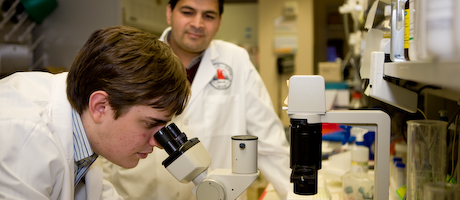By Jamie L. Freedman
It’s not every day that a teenager is listed as an author on a cardiothoracic research paper produced by the NIH’s National Heart, Lung, and Blood Institute.
GW freshman Caleb Seavey has been interning at the renowned medical research center since his senior year of high school, most recently conducting research in the field of xenotransplantation—the transplantation of organs and tissues across species with the ultimate goal of increasing the supply of organs available for human transplants.
His group’s latest findings were presented at the International Xenotransplantation Association’s conference in Venice last month and subsequently published in Xenotransplantation, the association’s professional journal, giving him credit as a co-author.
“It’s really exciting,” says Mr. Seavey, who is double majoring in biology and economics. “I have wanted to be a cardiothoracic surgeon since my sophomore year of high school, so it’s been a dream come true to work with such distinguished doctors and scientists in research that will potentially have a major impact on the lives of thousands of heart patients.”
His affiliation with the NHLBI began the summer before his senior year of high school, when he landed an internship with the Division of Prevention and Population Studies investigating the links between stroke mortality and environmental factors. “The work really drew me in,” says the Takoma Park, Md., native. “Then, last November I was offered an internship with the Cardiothoracic Surgery Research Group under the leadership of Keith Horvath.”
Mr. Seavey continued working at the NHLBI throughout his senior year at Montgomery Blair High School, spending 25 hours a week at the lab. In June, he was awarded a highly competitive Intramural Research Training Award Fellowship and spent the summer working in the institute’s Transplantation Section, guided by Muhammad Mohiuddin and Avneesh Singh. The lab focuses its research on the fast-growing field of xenotransplantation.
In a nutshell, the NHLBI researchers are investigating ways to combat xenograft organ rejection by working with pigs and baboons, whose anatomies are similar to humans. “One of the many barriers to successful xenotransplantation is organ rejection,” explains Mr. Seavey. “Our group is developing ways to use naturally occurring regulatory T (Treg) cells, which have a high immunospressant ability, expand them in-vitro, and then reintroduce them into the body to suppress the immune system and prevent xenograft rejection.”
Mr. Seavey was simultaneously involved with another NHLBI research project on stem cell research, which he hopes will also soon result in a paper. In addition to both research projects, Mr. Seavey was able to observe a number of open-heart surgeries on baboons and humans. He is planning to return to the Bethesda, Md., institute this summer. “Working at the NHLBI alongside some of the finest clinicians and researchers in the world is a high honor and gives me hope that someday I can actually be a serious contributor to the medical field.”
In the meantime, he’s enjoying life at GW. No stranger to the University, he is the son of two longtime GW professors: Emmy Award-winning filmmaker Nina Gilden Seavey, the founder and director of the Documentary Center at GW, and Ormond Seavey, a popular English professor. His sister, Eleanor, is a senior in the Elliott School of International Affairs. “I was born at GW Hospital and had my Bar Mitzvah at Hillel,” Mr. Seavey says. “I always kind of knew that I’d be going to GW. It’s great to be here!”


